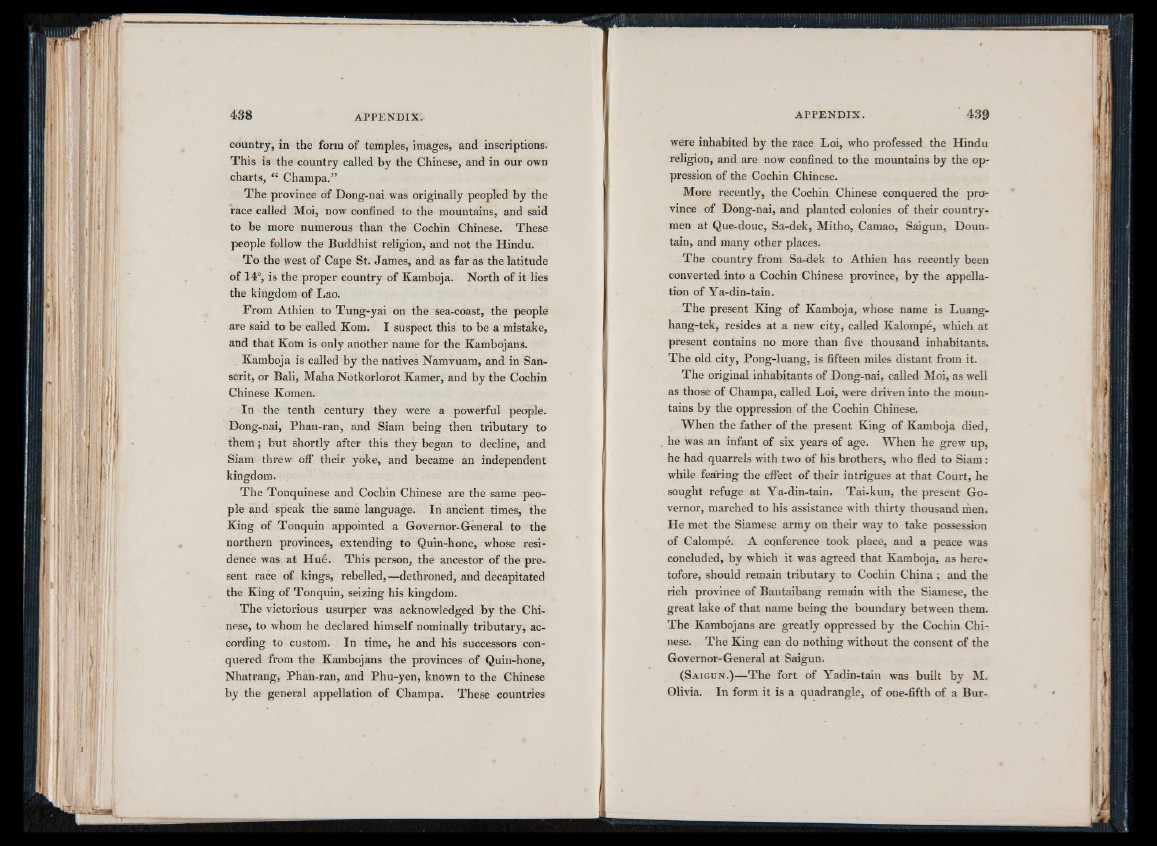
country, in the form of temples, images, and inscriptions.
This is the country called by the Chinese, and in our own
charts, “ Champa.”
The province of Dong-nai was originally peopled by the
race called Moi, now confined to the mountains, and said
to be more numerous than the Cochin Chinese. These
people follow the Buddhist religion, and not the Hindu.
T o the west of Cape St. James, and as far as the latitude
o f 14°, is the proper country of Kamboja. North o f it lies
the kingdom o f Lao.
From Athien to Tung-yai on the sea-coast, the people
are said to be called Kom. I suspect this to be a mistake,
and that Kom is only another name for the Kambojans.
Kamboja is called by the natives Namvuam, and in Sanscrit,
or Bali, Maha Notkorlorot Kamer, and by the Cochin
Chinese Komen.
In the tenth century they were a powerful people.
Dong-nai, Phan-ran, and Siam being then tributary to
them ; but shortly after this they began to decline, and
Siam threw off their yoke, and became an independent
kingdom.
Th e Tonquinese and Cochin Chinese are the same people
and speak the same language. In ancient times, the
King o f Tonquin appointed a Governor-General to the
northern provinces, extending to Quin-hone, whose residence
was at H u é . This person, the ancestor o f the present
race of kings, rebelled,—dethroned, and decapitated
the King of Tonquin, seizing his kingdom.
The victorious usurper was acknowledged by the Chinese,
to whom he declared himself nominally tributary, according
to custom. In time, he and his successors conquered
from the Kambojans the provinces o f Quin-hone,
Nhatrang, Phan-ran, and Phu-yen, known to the Chinese
by the general appellation o f Champa. These countries
were inhabited by the race Loi, who professed the Hindu
religion, and are now confined to the mountains by the oppression
of the Cochin Chinese.
More recently, the Cochin Chinese conquered the province
of Dong-nai, and planted colonies of their countrymen
at Que-douc, Sa-dek, Mitho, Camao, Saigun, Doun-
tain, and many other places.
The country from Sa-dek to Athien has recently been
converted into a Cochin Chinese province, by the appellation
o f Ya-din-tain.
The present King of Kamboja, whose name is Luang-
hang-tek, resides at a new city, called Kalompe, which at
present contains no more than five thousand inhabitants.
The old city, Pong-luang, is fifteen miles distant from it.
The original inhabitants of Dong-nai, called Moi, as well
as those of Champa, called Loi, were driven into the mountains
by the oppression of the Cochin Chinese.
When the father of the present King o f Kamboja died,
he was an infant o f six years of age. When he grew up,
he had quarrels with two o f his brothers, who fled to Siam:
while fearing the effect o f their intrigues at that Court, he
sought refuge at Ya-din-tain. Tai-kun, the present Governor,
marched to his assistance with thirty thousand men.
He met the Siamese army on their way to take possession
o f Calompe. A conference took place, and a peace was
concluded, by which it was agreed that Kamboja, as heretofore,
should remain tributary to Cochin C h in a ; and the
rich province of Bantaibang remain with the Siamese, the
great lake o f that name being the boundary between them.
The Kambojans are greatly oppressed by the Cochin Chinese.
The King can do nothing without the consent of the
Governor-General at Saigun.
( S a i g u n . ) — The fort of Yadin-tain was built by M.
Olivia. In form it is a quadrangle, o f one-fifth of a Bur